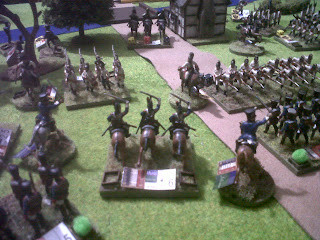The old version of GDW's Volley and Bayonet was used, complete with the scenario in the book. We hope to use the newer version at a later date (perhaps with the same scenario).
Figures are 20mm plastic and lead. Various manufacturers including Airfix, Hat, Italeri, Revell, Newline. 2/3 scale (2"x2") bases were used with appropriate movement and range adjustments. Table was 6'x4'.
The French right was weakly held, so much so that several Austrian brigades were able to secure the flank - or were they (?)
The centre would prove more problematic. Crossing the bridge in dense columns, with one eye on French movements, meant that the centre quickly became a morass of disorganised brigades.
Austrian cavalry focused on the French left, in the hope of defeating it early.
Immediate action in the centre.
French cavalry were quick to respond.
Murat and Kellerman leading their first charge of the day.
The Austrian centre still confused.
Note the little dice on the 2/3 scale bases. Quite good markers - especially so for casualties.
Inevitable melee. Always a dangerous proposition for both sides in the V&B rules.
French units quickly plugged the gap between the marsh and Marengo itself, where Austrian skirmishers were attempting to gain a foothold. Had the Austrians focused more of their main infantry body here, instead of trying to force it across a narrow bridge, matters in the centre might have been very different.
On the Austrian left, the flank was slowly being secured, despite the approach of French reinforcements.
While on the right, a massed cavalry action was developing.
Shots of the centre and left. By 1pm, the Austrians had secured a foothold across the river, but were becoming bogged down.
Despite Austrian confusion, they were beginning to gain the upper hand in the centre, their large numbers having more staying power than the rapidly mustered force of the French.
There remained one option. The French retreated and regrouped. having lost Marengo, they would make any attempts to take San Guiliano very costly for the Austrians however.
Given confidence by their securing of thecentre, and despite some doubt on the flanks, the Austrians attacked the new French lines head on - bringing them nicely into range of the French artillery batteries which had sat in the vineyards to the east for most of the game.
Some shots of the dice markers in action, combined with some mini 'poms poms'. Green is 'stationary', red or yellow is 'disorder', and black indicates casualties - the number on the black dice indicating hits taken.
Murat, having got the better of the Austrian flank, leads a cavalry charge 'around' their rear to secure his left - straight into the scattered remnants of the depleted Austrian flanking force. Vive L'Empereur!
By game end, the Austrians have nothing left to take their remaining objective with, and the French win the day! By 5pm (turn 9), it is all over. Four Austrian divisions have retreated or collapsed and only Marengo is held.
Volley and Bayonet is a wonderful set of rules, although there are several non-intuitive elements which have to be remembered (morale in contact, retreat vs rout etc.). Experience with these nuances makes them second nature however. More V&B to follow, between bouts of Force on Force and the new WW2 game 'Blood & Guts'.
Oh yes, and finally, MERRY CHRISTMAS to all.





















































